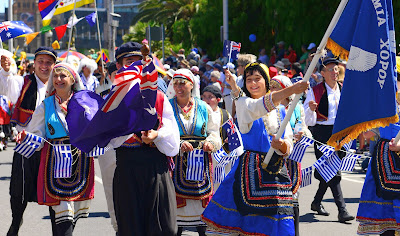In the U.S., when we think of Independence Day, we think of fireworks, barbeques, and celebrating our history as an independent country. But what many may not realize is that other forms of Independence Day are celebrated across the globe. In fact, over 100 countries and territories have some sort of commemoration honoring their independence or statehood! Most countries observe their respective independence days as national holidays, with unique events and activities that embrace culture and tradition.
Mexico, September 15 &16
Mexicans honor the first proclamation of independence in 1810, at the onset of Mexico's (then New Spain's) 10-year war with Spain. The celebration begins at 11 p.m. on Sept. 15 when the president rings the historic liberty bell. Crowds gather and shout, "El Grito," or "Mexicanos, Viva Mexico!" and sing the National Anthem. This commemorates the call for freedom made by the Catholic priest Hidalgo, who was one of the nation’s leaders during the War of Independence in Mexico. The day is highlighted with rodeos, bullfights, parades, and traditional Mexican dances.
Peru, July 27 & 28
Like the Mexicans, Peruvians begin their celebration on the night before their Independence Day. July 28th commemorates the liberation of Peru from Spain by José de San Martin, the most famous liberator of Latin America aside from the Liberator himself, Simón Bolívar. The following day, July 29th, recognizes the establishment of the Republic of Perú. Together these two days are called Las Fiestas Patrias, and are by far the most important national holidays in Peru. Streets are filled with music and small parties, and the flag of Peru flies from nearly every building. In Lima, the official celebration takes place in Parque de la Muralla, where a huge variety of Peruvian music and dances take place. Official fireworks begin at midnight, and there is an amazing 3-D light show at the Fantasia Fountain in Centro De Lima.
Australia, January 26
Australia Day started as a day of recognition for emancipated convicts and has evolved into what is now a celebration that reflects the nation's diverse people. Extremely popular, this day is observed by more than half of the population. Records of celebration date back to as early as 1808. In Sydney, popular events include a ferry race, a surfing race, and a tall ships race. Fireworks launched from skyscrapers are also common.
India, August 15
In India, Aug. 15 represents the end of British colonial rule in 1947. The prime minister's speech represents the peak of festivities. Flag-hoisting ceremonies occur in state capitals, schools, and individual homes. Throughout the country, a popular tradition of flying kites has emerged and is actually quite competitive. Children and adults try to make each others’ kites fall to the ground by cutting the strings.
Kenya, December 12
Jamhuri Day is the Kenyan day of Independence, celebrated on the 12th of December each year. Jamhuri is Swahili for ‘republic’, and the day represents two momentous occasions: the day Kenya became a republic and the day the country became free from the United Kingdom.
Many festivals are held which celebrate Kenya’s unique cultural identity. Kenyans dress in traditional outfits that include Kikoys – vibrantly-colored, handwoven cloth that can be wrapped around the waist or the neck, and Kitenges, which are East-African fabrics that women wear as beautiful dresses or headscarves. Kenyans pull out all the stops and fill this day with many traditional foods, songs, and dances that create a resplendent event that definitely honors their country in the best way possible.
Norway, May 17
Norwegian National Day, better known as Syttende mai, marks the signing of Norway’s Constitution. Colorful processions of children march with flags and school banners in festive parades. In the capital city of Oslo, the children pass the Royal Palace, where the royal family will wave to the pint-sized parade participants from the balcony. Another special characteristic that contributes to making Constitution Day unique is all of the beautiful "Bunads" (the traditional Norwegian costumes) worn by local residents. The day is essentially an “eat whatever you want” day. So ice cream, waffles, cakes, hot dogs and other fast foods are consumed.
Costa Rica, September 14 & 15
Costa Rica’s Independence Day commemorates the independence of Central America from Spain, which took place in 1821. The news of the country’s independence reached the nation’s people about a month after the declaration of independence that occurred in Guatemala. This day is celebrated with much joy and cheerfulness.
Even though September 15th is Costa Rica’s official Independence Day, festivities begin on the 14th, with the reenactment of the notification of Costa Rica’s liberation. At exactly 6:00 p.m., national TV and radio stations broadcast Costa Rica’s National Anthem, as the entire country sings along in a burst of patriotism. Following the Anthem, the popular ‘faroles’ parade of homemade lanterns symbolizing the original freedom torch, begins. Children in traditional costumes perform dances as fireworks commence. Typical Costa Rican foods, such as arroz con pollo, tamales, fried yucca, and fried plantains, are available for sale in stands along the roads.
Indonesia, August 17th
Indonesians recognize their independence from the Dutch and Japanese by decorating their houses and streets with red and white ornaments which represent the colors of Indonesian flags. After the flag ceremonies, the more informal celebrations begin with all kind of competitions taking place, including panjat pinang, a game that requires a tall nut tree, buckets of prizes, and a lot of oil. The trees are positioned vertically with prizes at the top, and are oiled up. Then everyone works together, using each other’s bodies as step stools, to clamber to the top and grab one of the goodies. Climbing the tree symbolizes the effort it took to gain independence.
Other traditions include a multitude of cultural performances, parades, athletic events, and eating Indonesian crackers (known as 'krupuk').
What makes your Independence Day special? Share your traditions with us below!







No comments:
Post a Comment
Thank you for your comment!